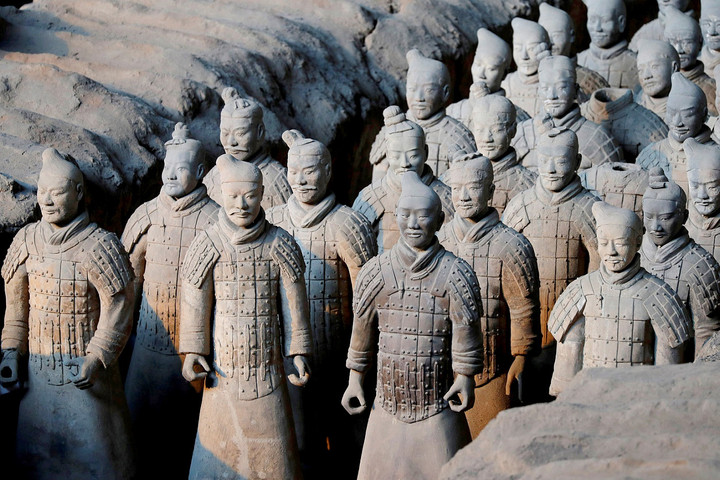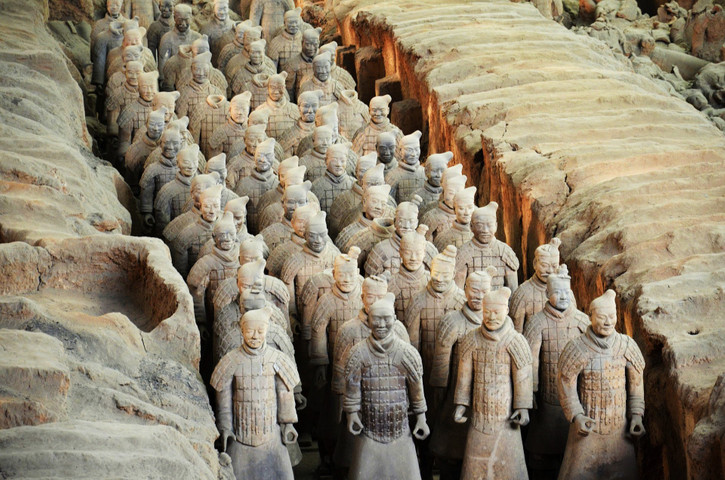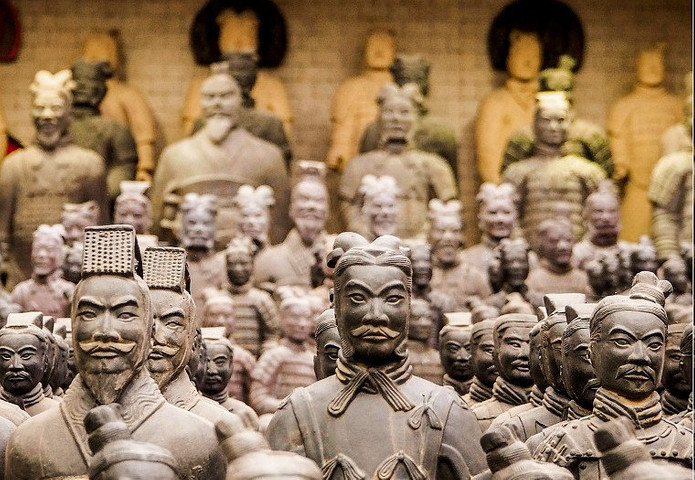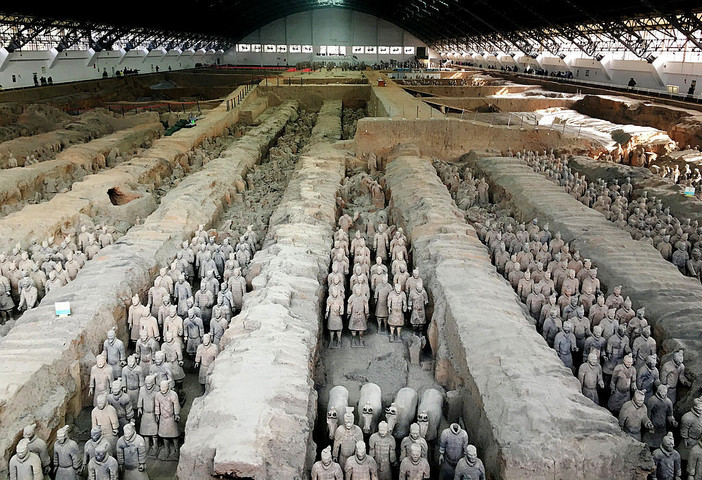The History of Terracotta Warriors
 Terracotta warriors is the greatest archaeological discovery that is hiding the whole era of Ancient China.
In 1974, when a group of farmers and peasants dig a well in the Shaanxi province in the northwest china and discovered some pottery, that evidence led to the greatest archeological discovery of the history. When the archeological team reached at the spot to inspect the area they discovered the extraordinary treasure near the tomb of the China’s first emperor Qin Shi Huang, who ruled over china in 221B.C. The archeology teams started digging up the pits near tomb and they found an entire army of life size sculptures of soldiers along with horses and carriages.
Over the course of 35 years they have located six hundred pits in the total area of 22 square miles area. Out of these 600 pits only three of them are easily accessible and they are filled with hundreds of proudly standing life size clay soldiers. These terracotta warriors left archeologists and historians scratch their head. There are 8000 sculpted soldiers found standing in long columns in pits. These buried warriors are undoubtedly the biggest discovery in archeology.
These terracotta soldiers are the strongest evidence of the artistic abilities of the ancient Chinese people and their physical construction skills. These terracotta warriors are famous for their unique individuality. From these 800 standing sculptures there isn’t a single sculpture that is similar to the other. Each and every solider had his owns distinct facial features, height, body shape and even the armor worn by the soldiers. This proves that every sculpture was build individually. These warriors are holding cross bows and weapons to defend the emperorand they are standing alert and ready for every war that is about to happen. This represents the glory and great craftsmanship by the laborers of that era. This much uniqueness and hard work represents that these sculptures were build over the course of decades in the emperor’s Era.
Terracotta warriors is the greatest archaeological discovery that is hiding the whole era of Ancient China.
In 1974, when a group of farmers and peasants dig a well in the Shaanxi province in the northwest china and discovered some pottery, that evidence led to the greatest archeological discovery of the history. When the archeological team reached at the spot to inspect the area they discovered the extraordinary treasure near the tomb of the China’s first emperor Qin Shi Huang, who ruled over china in 221B.C. The archeology teams started digging up the pits near tomb and they found an entire army of life size sculptures of soldiers along with horses and carriages.
Over the course of 35 years they have located six hundred pits in the total area of 22 square miles area. Out of these 600 pits only three of them are easily accessible and they are filled with hundreds of proudly standing life size clay soldiers. These terracotta warriors left archeologists and historians scratch their head. There are 8000 sculpted soldiers found standing in long columns in pits. These buried warriors are undoubtedly the biggest discovery in archeology.
These terracotta soldiers are the strongest evidence of the artistic abilities of the ancient Chinese people and their physical construction skills. These terracotta warriors are famous for their unique individuality. From these 800 standing sculptures there isn’t a single sculpture that is similar to the other. Each and every solider had his owns distinct facial features, height, body shape and even the armor worn by the soldiers. This proves that every sculpture was build individually. These warriors are holding cross bows and weapons to defend the emperorand they are standing alert and ready for every war that is about to happen. This represents the glory and great craftsmanship by the laborers of that era. This much uniqueness and hard work represents that these sculptures were build over the course of decades in the emperor’s Era.
 The technique the ancient artists used to make these sculpture is later on detected and explained. There are many terracotta sculptures that are found without heads and detached bodyparts. These evidences shows that legs, arms, torsos and heads were made separately and then assembled to form the complete model. Then they burn them to make the clay hard and durable. At the end the artists painted them and make them stand next to the previous solider standing in the column. According to many records of archeologists and historians this is the cruelest act by the emperor to invest empire’s huge portion of treasure into just an underground palace. After his death the construction of terracotta soldiers was stopped by the next emperor and this can be reason why some pits were found empty in the underground place.
Historian believe that these soldiers were build to escort the emperor in afterlife. These soldiers and horses are standing facing the tomb of Qin Shi Huang like they are protecting the buried emperor. Qin Shi Huang is considered the strongest emperor of China and a great conqueror who invaded land and expanded Chinese territory. He was very innovative for thinking ahead of his time because he introduced the standardized currency, writing practices and measurements. The Great Wall of China was also started building in his reign to protect the Chinese territories from invaders. He is always credited for the great wall because it is still the identification symbol of china that represents architecture and history of the great ancient Chinese kingdom.
He was a great military leader who is known for being the superior in wars and for his method of massacre and destruction. According to the historical record he was obsessed with immorality and victory. His biggest achievement was to unite the divided empire. His reign is the most powerful in Chinese history. He had a legacy to make Qin dynasty a strongest empire with huge influence and power that passed on to the future dynasties over the next two millennia.
The emperor was so obsessed with living forever and that’s why he ordered to start building the underground mausoleum right after taking the Throne at the age of 13. He instructed the laborers and artisans to build an underground palace with almost 8000 terracotta sculpted warriors equipped with horses and chariots that can escort him to the afterlife and protect him from all hazards. Those soldiers were buried along with the whole tomb and complex. It is also seen by the historians that emperor Qin Shi looked to the cosmos as a guide to cross over an immortal existence and for this purpose he lined the burial complex with the treasury of riches and piles of precious gemstones that represents stars, sun and moon. Therefore after digging up the site the archeologists discovered bronze ritual vessels, gold, jade jewelry and silver ornaments. Excavations proves that he also experimented with Mercury and crossed it through the intricate systems of underground troughs because the emperor believed that by surrounding him with this toxic element yet life giving element, he can get to live forever without dying. According to one account of history it took 720,000 builders to build whole tomb and soldiers.
The technique the ancient artists used to make these sculpture is later on detected and explained. There are many terracotta sculptures that are found without heads and detached bodyparts. These evidences shows that legs, arms, torsos and heads were made separately and then assembled to form the complete model. Then they burn them to make the clay hard and durable. At the end the artists painted them and make them stand next to the previous solider standing in the column. According to many records of archeologists and historians this is the cruelest act by the emperor to invest empire’s huge portion of treasure into just an underground palace. After his death the construction of terracotta soldiers was stopped by the next emperor and this can be reason why some pits were found empty in the underground place.
Historian believe that these soldiers were build to escort the emperor in afterlife. These soldiers and horses are standing facing the tomb of Qin Shi Huang like they are protecting the buried emperor. Qin Shi Huang is considered the strongest emperor of China and a great conqueror who invaded land and expanded Chinese territory. He was very innovative for thinking ahead of his time because he introduced the standardized currency, writing practices and measurements. The Great Wall of China was also started building in his reign to protect the Chinese territories from invaders. He is always credited for the great wall because it is still the identification symbol of china that represents architecture and history of the great ancient Chinese kingdom.
He was a great military leader who is known for being the superior in wars and for his method of massacre and destruction. According to the historical record he was obsessed with immorality and victory. His biggest achievement was to unite the divided empire. His reign is the most powerful in Chinese history. He had a legacy to make Qin dynasty a strongest empire with huge influence and power that passed on to the future dynasties over the next two millennia.
The emperor was so obsessed with living forever and that’s why he ordered to start building the underground mausoleum right after taking the Throne at the age of 13. He instructed the laborers and artisans to build an underground palace with almost 8000 terracotta sculpted warriors equipped with horses and chariots that can escort him to the afterlife and protect him from all hazards. Those soldiers were buried along with the whole tomb and complex. It is also seen by the historians that emperor Qin Shi looked to the cosmos as a guide to cross over an immortal existence and for this purpose he lined the burial complex with the treasury of riches and piles of precious gemstones that represents stars, sun and moon. Therefore after digging up the site the archeologists discovered bronze ritual vessels, gold, jade jewelry and silver ornaments. Excavations proves that he also experimented with Mercury and crossed it through the intricate systems of underground troughs because the emperor believed that by surrounding him with this toxic element yet life giving element, he can get to live forever without dying. According to one account of history it took 720,000 builders to build whole tomb and soldiers.
 The emperor Qin Shi Huang contracted with Fatal illness and died at the age of 49 and now laying in the tomb. He couldn’t stop his death to come but still he give the biggest contribution to the Chinese history in all aspects. The whole site of the terracotta warriors and the pits are transformed into indoor museum named Terracotta Museum in the city of Xian in Shaanxi Province. Million of tourists annually visit this one of the most remarkable historical site and incredible artifacts. Although many Archeological teams tried to do further research in the tomb to find about what is buried in there but Chinese people and the government didn’t allow it because it is one of most important site of their origin and history.
The director of the terracotta Museum Wu Yongqi said, “"I have a dream that one day science can develop so that we can tell what is here without disturbing the emperor, who has slept here for 2,000 years”. He told that how further digging and exploring can disturb whole construction and the pride of the final resting place of the first Emperor. Further lighting over the importance of the Emperor Qin Shi Huang he said, "For all Chinese people, he is our ancestor, and for what he did for China, we cannot unearth his tomb just because archaeologists or people doing tourism want to know what is buried there."
The emperor Qin Shi Huang contracted with Fatal illness and died at the age of 49 and now laying in the tomb. He couldn’t stop his death to come but still he give the biggest contribution to the Chinese history in all aspects. The whole site of the terracotta warriors and the pits are transformed into indoor museum named Terracotta Museum in the city of Xian in Shaanxi Province. Million of tourists annually visit this one of the most remarkable historical site and incredible artifacts. Although many Archeological teams tried to do further research in the tomb to find about what is buried in there but Chinese people and the government didn’t allow it because it is one of most important site of their origin and history.
The director of the terracotta Museum Wu Yongqi said, “"I have a dream that one day science can develop so that we can tell what is here without disturbing the emperor, who has slept here for 2,000 years”. He told that how further digging and exploring can disturb whole construction and the pride of the final resting place of the first Emperor. Further lighting over the importance of the Emperor Qin Shi Huang he said, "For all Chinese people, he is our ancestor, and for what he did for China, we cannot unearth his tomb just because archaeologists or people doing tourism want to know what is buried there."
 No matter how much mores studies and explorations can reveal but some things aren’t going to change such as the importance of First emperor Qin Shi Huang in Chinese culture and history and secondly the significance and influence of his reign over the development of Qin dynasty.
No matter how much mores studies and explorations can reveal but some things aren’t going to change such as the importance of First emperor Qin Shi Huang in Chinese culture and history and secondly the significance and influence of his reign over the development of Qin dynasty.
 The technique the ancient artists used to make these sculpture is later on detected and explained. There are many terracotta sculptures that are found without heads and detached bodyparts. These evidences shows that legs, arms, torsos and heads were made separately and then assembled to form the complete model. Then they burn them to make the clay hard and durable. At the end the artists painted them and make them stand next to the previous solider standing in the column. According to many records of archeologists and historians this is the cruelest act by the emperor to invest empire’s huge portion of treasure into just an underground palace. After his death the construction of terracotta soldiers was stopped by the next emperor and this can be reason why some pits were found empty in the underground place.
Historian believe that these soldiers were build to escort the emperor in afterlife. These soldiers and horses are standing facing the tomb of Qin Shi Huang like they are protecting the buried emperor. Qin Shi Huang is considered the strongest emperor of China and a great conqueror who invaded land and expanded Chinese territory. He was very innovative for thinking ahead of his time because he introduced the standardized currency, writing practices and measurements. The Great Wall of China was also started building in his reign to protect the Chinese territories from invaders. He is always credited for the great wall because it is still the identification symbol of china that represents architecture and history of the great ancient Chinese kingdom.
He was a great military leader who is known for being the superior in wars and for his method of massacre and destruction. According to the historical record he was obsessed with immorality and victory. His biggest achievement was to unite the divided empire. His reign is the most powerful in Chinese history. He had a legacy to make Qin dynasty a strongest empire with huge influence and power that passed on to the future dynasties over the next two millennia.
The emperor was so obsessed with living forever and that’s why he ordered to start building the underground mausoleum right after taking the Throne at the age of 13. He instructed the laborers and artisans to build an underground palace with almost 8000 terracotta sculpted warriors equipped with horses and chariots that can escort him to the afterlife and protect him from all hazards. Those soldiers were buried along with the whole tomb and complex. It is also seen by the historians that emperor Qin Shi looked to the cosmos as a guide to cross over an immortal existence and for this purpose he lined the burial complex with the treasury of riches and piles of precious gemstones that represents stars, sun and moon. Therefore after digging up the site the archeologists discovered bronze ritual vessels, gold, jade jewelry and silver ornaments. Excavations proves that he also experimented with Mercury and crossed it through the intricate systems of underground troughs because the emperor believed that by surrounding him with this toxic element yet life giving element, he can get to live forever without dying. According to one account of history it took 720,000 builders to build whole tomb and soldiers.
The technique the ancient artists used to make these sculpture is later on detected and explained. There are many terracotta sculptures that are found without heads and detached bodyparts. These evidences shows that legs, arms, torsos and heads were made separately and then assembled to form the complete model. Then they burn them to make the clay hard and durable. At the end the artists painted them and make them stand next to the previous solider standing in the column. According to many records of archeologists and historians this is the cruelest act by the emperor to invest empire’s huge portion of treasure into just an underground palace. After his death the construction of terracotta soldiers was stopped by the next emperor and this can be reason why some pits were found empty in the underground place.
Historian believe that these soldiers were build to escort the emperor in afterlife. These soldiers and horses are standing facing the tomb of Qin Shi Huang like they are protecting the buried emperor. Qin Shi Huang is considered the strongest emperor of China and a great conqueror who invaded land and expanded Chinese territory. He was very innovative for thinking ahead of his time because he introduced the standardized currency, writing practices and measurements. The Great Wall of China was also started building in his reign to protect the Chinese territories from invaders. He is always credited for the great wall because it is still the identification symbol of china that represents architecture and history of the great ancient Chinese kingdom.
He was a great military leader who is known for being the superior in wars and for his method of massacre and destruction. According to the historical record he was obsessed with immorality and victory. His biggest achievement was to unite the divided empire. His reign is the most powerful in Chinese history. He had a legacy to make Qin dynasty a strongest empire with huge influence and power that passed on to the future dynasties over the next two millennia.
The emperor was so obsessed with living forever and that’s why he ordered to start building the underground mausoleum right after taking the Throne at the age of 13. He instructed the laborers and artisans to build an underground palace with almost 8000 terracotta sculpted warriors equipped with horses and chariots that can escort him to the afterlife and protect him from all hazards. Those soldiers were buried along with the whole tomb and complex. It is also seen by the historians that emperor Qin Shi looked to the cosmos as a guide to cross over an immortal existence and for this purpose he lined the burial complex with the treasury of riches and piles of precious gemstones that represents stars, sun and moon. Therefore after digging up the site the archeologists discovered bronze ritual vessels, gold, jade jewelry and silver ornaments. Excavations proves that he also experimented with Mercury and crossed it through the intricate systems of underground troughs because the emperor believed that by surrounding him with this toxic element yet life giving element, he can get to live forever without dying. According to one account of history it took 720,000 builders to build whole tomb and soldiers.
 The emperor Qin Shi Huang contracted with Fatal illness and died at the age of 49 and now laying in the tomb. He couldn’t stop his death to come but still he give the biggest contribution to the Chinese history in all aspects. The whole site of the terracotta warriors and the pits are transformed into indoor museum named Terracotta Museum in the city of Xian in Shaanxi Province. Million of tourists annually visit this one of the most remarkable historical site and incredible artifacts. Although many Archeological teams tried to do further research in the tomb to find about what is buried in there but Chinese people and the government didn’t allow it because it is one of most important site of their origin and history.
The director of the terracotta Museum Wu Yongqi said, “"I have a dream that one day science can develop so that we can tell what is here without disturbing the emperor, who has slept here for 2,000 years”. He told that how further digging and exploring can disturb whole construction and the pride of the final resting place of the first Emperor. Further lighting over the importance of the Emperor Qin Shi Huang he said, "For all Chinese people, he is our ancestor, and for what he did for China, we cannot unearth his tomb just because archaeologists or people doing tourism want to know what is buried there."
The emperor Qin Shi Huang contracted with Fatal illness and died at the age of 49 and now laying in the tomb. He couldn’t stop his death to come but still he give the biggest contribution to the Chinese history in all aspects. The whole site of the terracotta warriors and the pits are transformed into indoor museum named Terracotta Museum in the city of Xian in Shaanxi Province. Million of tourists annually visit this one of the most remarkable historical site and incredible artifacts. Although many Archeological teams tried to do further research in the tomb to find about what is buried in there but Chinese people and the government didn’t allow it because it is one of most important site of their origin and history.
The director of the terracotta Museum Wu Yongqi said, “"I have a dream that one day science can develop so that we can tell what is here without disturbing the emperor, who has slept here for 2,000 years”. He told that how further digging and exploring can disturb whole construction and the pride of the final resting place of the first Emperor. Further lighting over the importance of the Emperor Qin Shi Huang he said, "For all Chinese people, he is our ancestor, and for what he did for China, we cannot unearth his tomb just because archaeologists or people doing tourism want to know what is buried there."
 No matter how much mores studies and explorations can reveal but some things aren’t going to change such as the importance of First emperor Qin Shi Huang in Chinese culture and history and secondly the significance and influence of his reign over the development of Qin dynasty.
No matter how much mores studies and explorations can reveal but some things aren’t going to change such as the importance of First emperor Qin Shi Huang in Chinese culture and history and secondly the significance and influence of his reign over the development of Qin dynasty.
